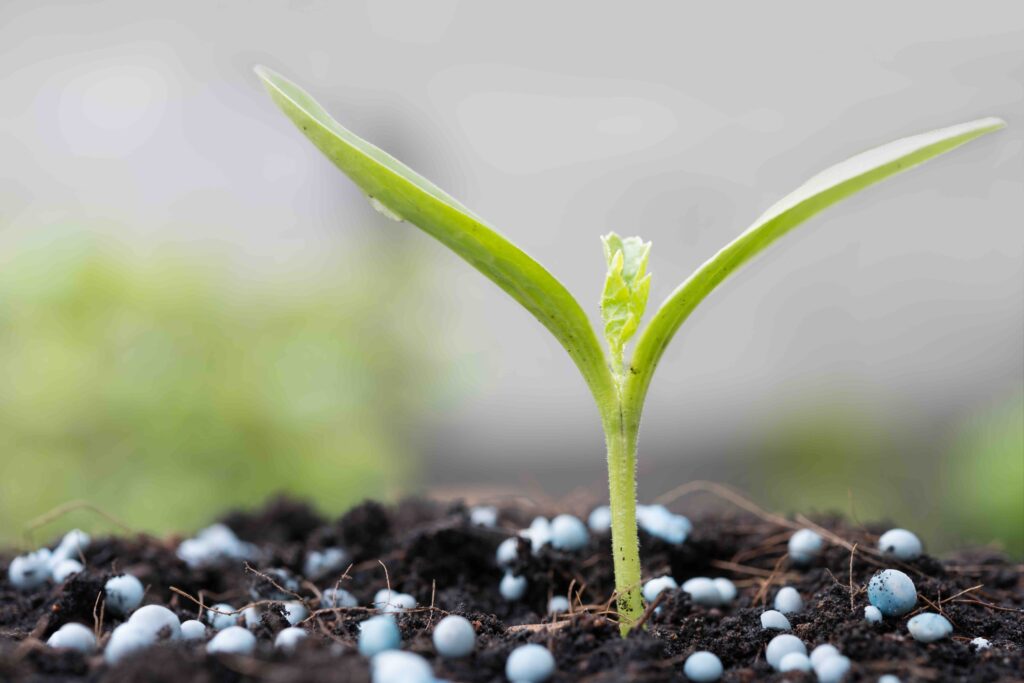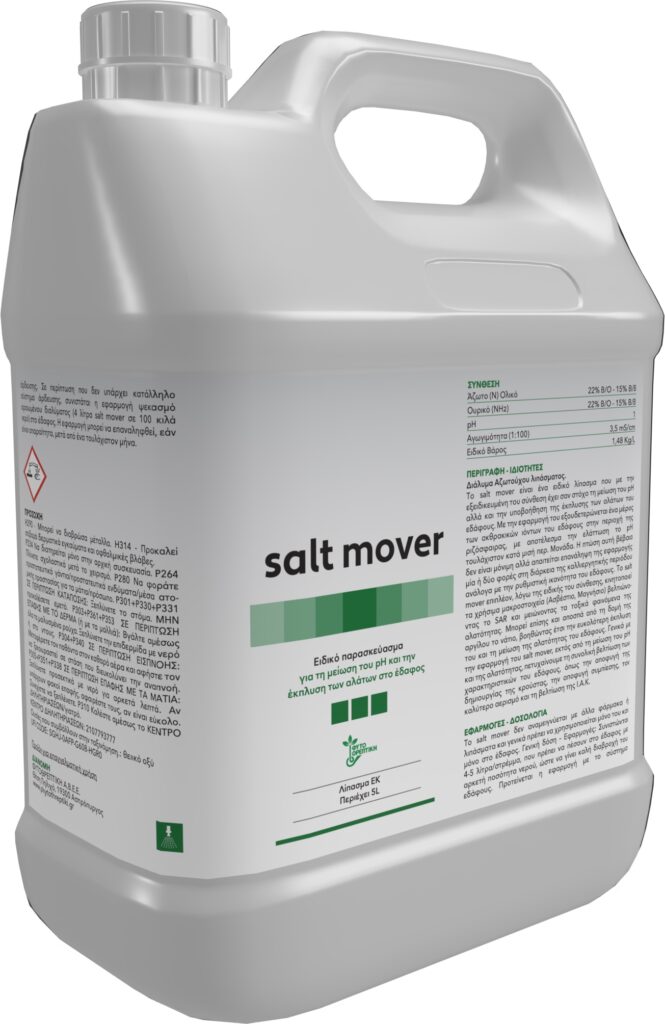
What is it? It is the total water-soluble salts that accumulate in the surface and deeper layers of the soil. These salts are mainly Ca, Mg, Na, K and NH4 carbonates, bicarbonates, borates, sulphates, chlorides and nitrates, their relative proportions in the soil solution being of no particular significance in terms of salinity.
Origin: these salts come from rocks and minerals that are being weathered, from water used to irrigate crops and the high level of the water table (groundwater) or from the influence of the sea when it is at a close distance and from fertilisation. Fertilisation, along with irrigation water are the anthropogenic origins of soil salinity.
Effects on plants: their effect is to create toxic conditions for plant growth, as is the case mainly with chlorides and borates, or to increase the osmotic pressure of the soil, as is the case mainly with sulphates, resulting in the inability of the roots to absorb nutrients and water.
Further damage can result from an increase in soil pH, as well as structural degradation and the consequent reduced downward water movement, poor aeration and difficulty of mechanical processing.
Finally, the normal growth of plants or even the completion of their biological cycle is hindered. Most commonly – in cultivated crops – achieving normal yields is hindered resulting in smaller yields.
Saline soils: are those containing water-soluble salts in such an amount that damage and reduced yields are caused to most crops.
What is the percentage of salts in a soil above which the aforementioned damage occurs? It is not possible to define a threshold percentage that applies to all cases, as the effect of a given percentage depends on the type of salts, the organic matter content and, above all, the mechanical composition of the soil. Thus, a salt content of 4%, for example, in a soil with a heavy mechanical composition, i.e. capable of retaining sufficient moisture, would correspond to a thinner solution than a sandy soil, which is less capable of retaining moisture. In the case of sandy soil, the increase in osmotic pressure and the toxic effects of salts would, thus, be greater than in heavy soil for the same percentage of salts. We must, therefore, look for another way of measuring soil salinity.
Why don’t we measure the osmotic potential of the soil solution directly? Indeed, measuring the osmotic potential of the soil solution would give us a very accurate and direct picture of the harmful or non-harmful concentration of water-soluble salts in the soil. However, it is difficult to separate a sufficient amount of solution from a soil sample for direct measurement of the osmotic potential, especially in a laboratory that has to analyse a large number of samples per day.
Then how do we measure the water-soluble salt content of the soil? We indirectly measure the salt content through another property of the soil solution that depends on the total salts in the soil that affect osmotic pressure. This is the electrical conductivity (C) of the soil solution. By this term we mean the ease with which an electric current passes through the soil solution. This always depends on the presence of charge carriers within the solution: electrons and ions. In the case of soil, the ions that determine the value of C are the ions of the water-soluble salts in the soil solution that we want to evaluate, since they are not present in the deionised water we use. Thus, soils rich in salts more readily conduct electricity and have a high electrical conductivity. Specific electrical conductivity is the value of the electrical conductivity of a soil solution as measured by standard laboratory apparatus: it is the conductivity of a solution when measured with two electrodes with a surface area of 1cm2 separated by 1cm, at 25°C. The unit of measurement of electrical conductivity is mho/cm. The determination of water-soluble salts is carried out in two steps: first is the removal – extraction of the salts from the solid state through water, followed by the measurement of the specific electrical conductivity in the extract.
How do we obtain the soil extract whose specific electrical conductivity we will measure? We can extract with different amounts of water. For example, if it were practically easy, we could measure near the wilting point, but the value would be of little interest, since plants face a much more serious risk due to the lack of water. We would want the specific electrical conductivity to be measured at a percentage of soil moisture such that it corresponds to normal plant activity, i.e. a percentage that is in direct relation to the upper and lower limit of soil water available to plants. This is ensured when we add an amount of water to the soil sample that is equal to the saturation water, i.e. the maximum amount of water retained by soil when the addition of water has brought the sample to a muddy state, the saturation paste. After adding water, the resulting paste is checked for its glossiness, the coverage of the line drawn on its surface, its viscosity and the presence or absence of free water so as to know when the saturation paste has been achieved.
Saturation water is related to other constants of the moisture status of the soil, such as the water retention capacity and the permanent wilting point. Thus, the % moisture saturation is 4 times greater than the moisture content at the permanent wilting point (15atm) and 2 times greater than the water at the water retention capacity (0.3atm) satisfying the relationship mentioned above.
From the saturation paste we obtain via filtration or centrifugation the saturation extract, with which we measure the specific electrical conductivity and the contents of water-soluble anions and cations in the soil.
What are the limits of crop growth in terms of soil conductivity? Measuring the specific electrical conductivity in the saturation paste the limits are:
- 0-2 mhos/cm: soil without salinity problems. No limitation in terms of salinity.
- 2-4 mhos/cm: soils with very slight salinity, unsuitable for very sensitive plants.
- 4-8 mhos/cm: slightly saline soils where the growth of most plants is restricted.
- 8-15mhos/cm: moderately saline soils. Only salt-tolerant plants survive.
- >15 mhos/cm: strongly saline. Only highly salt-tolerant plants survive.
What other measurements can be made for soil conductivity? Although the above scale, which can be used to evaluate the suitability of a soil, exists for measurements in saturated paste, there are other methods based on measuring the conductivity of soil-water suspensions in 1:1, 1:2 or 1:5 (soil to water) ratios. In these cases, we should be able to evaluate the measurements, since we can no longer rely on the values classes obtained from saturation paste. The laboratory that has opted for these methods will probably provide the corresponding information.
PHYTOTHREPTIKI recommends:

SALT MOVER
A special formulation for pH reduction and soil salt leaching.
VIOMIX MINOR PH & SALT is a special nutrition product, whose special formulation aims to reduce the pH and assist to the leaching of soil salts.
By applying VIOMIX MINOR PH & SALT, a part of the carbonate ions in the rhizosphere zone is neutralised, resulting in a pH reduction of at least half a point.
Application needs to be repeated 1 – 2 times during the growing season, depending on the buffering capacity of the soil, in order to maintain the reduced pH value.
In addition, VIOMIX MINOR PH & SALT is also based on polycarboxylic acids, extracting sodium ions from soil colloids, resulting in a reduction in soil salinity.
In addition to reducing soil pH and soil salinity, the application of VIOMIX MINOR PH & SALT ensures an overall improvement of soil characteristics, such as:
- Prevention of crust formation.
- Prevention of soil compaction.
- Better aeration.
- Higher cation-exchange capacity

